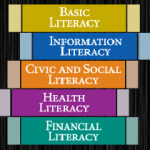As I browsed through PA Forward’s Best Practices database recently, I couldn’t help but notice that the majority of contributions came from public libraries. In general, I have observed that my academic librarian colleagues are less likely to incorporate PA Forward branding than their peers in public libraries. One reason for this may be that PA Forward’s efforts to promote the value of Pennsylvania’s libraries—from raising community awareness and educating lawmakers to forming private partnerships and crafting a unified message– often seem more directly relevant to the challenges facing public and school librarians. Academic librarians, on the other hand, are more often keenly focused on operating effectively within the social, political, and budgetary constraints of our particular home institutions. However, according to Jennifer Luksa, Director of Library Services at Misericordia University’s Bevevino Library, “with school districts eliminating school libraries and adding pressure to our public libraries who also have felt budget cuts over the years, we see a need for all libraries and librarians in the state to be a team for all our patrons.” She adds that it is not uncommon for patrons of the local public library and local K-12 students to seek assistance at her institution. 
Another reason that PA Forward initiatives and materials may be overlooked by academic librarians is that we tend to focus on information literacy much more than the other four literacies emphasized by PA Forward– basic, financial, health, and civic and social literacy. This may be changing, however, as academic librarians develop innovative new services and programs in order to meet both the changing needs and expectations of our users and broader institutional challenges. For example, in hopes of contributing to increased student retention, academic libraries increasingly offer programming that supports the development of the “whole” student, rather than just the research needs associated with particular assignments. At Penn State York, Head Librarian Barb Eshbach created a game-based First Year Experience (FYE) program called ConnectED that incorporates the five literacies of PA Forward and some thoughtful co-branding (http://sites.psu.edu/connected/connected-the-challenge/). Students earn points by attending library-sponsored events and making personal connections on campus; the winner receives a monetary award to be applied to their next semester’s tuition at Penn State York.
While developing a similar program at one’s own institution may seem daunting, once you begin to examine your programming with the five literacies as a frame of reference, you may realize that you already offer programs, services, and partnerships that promote multiple literacies. If you want to see what other libraries are doing, consult the PA Forward Best Practices website (https://www.palibraries.org/?page=BestOfPAFwd) and remember to share your own activities by submitting them for inclusion in the PA Forward Best Practices database.
In our current economic and information landscape, libraries of all types are under pressure to demonstrate their continued relevance. “By participating in PA Forward activities and initiatives as an academic library,” explains Luksa, “you get your institution’s name out in the community, not only as a marketing tool for PA Forward, but also as recognition for your college or university.” Learn more about the PA Forward Best Practices: https://www.palibraries.org/?page=BestOfPAFwd


